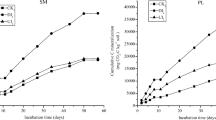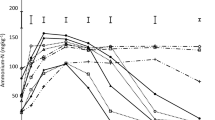Abstract
Yak and Tibetan sheep grazing is a common phenomenon on natural grasslands in the Qinghai-Tibetan Plateau, and large amounts of excrement are directly deposited onto alpine grasslands. However, little is known about the effects of excrement return on soil N supply and N retention capacity. This study investigated the short-term effects of yak and Tibetan sheep dung on gross N transformation rates determined by 15N tracing technique of alpine steppe (AS) and meadow (AM) soils at 60 % water holding capacity (WHC) under laboratory conditions. Cumulative gross N mineralization and NH4 + immobilization over the 21-day incubation period in AM soil were around 2.8 and 2.0 times as high as that in AS soil, respectively. Cumulative gross nitrification in AM soil was 0.96 times higher, while the value of gross NO3 − immobilization rate was 0.65 times lower than in AS soil, resulting in higher NO3 − accumulation in AM soil. Dung addition increased soil gross N mineralization and NH4 + immobilization rates by 12–35 % and 17–59 %, respectively. Amending yak and sheep dung decreased gross nitrification rates by 3–23 % but increased gross NO3 − immobilization rates by 25–190 %, which led to a decreased net NO3 − accumulation and NO3 − losses risk through leaching. The cumulative CO2 emissions over the 21 days of incubation period were enhanced by 65 and 120 % for AS and AM soil, respectively. The application of dung stimulated cumulative N2O emissions, but the stimulation was only significant in AM soil. In general, yak and sheep dung return has a positive effect on soil N supply and retention owing to the increase in NH4 + availability for plant with simultaneously decreasing NO3 − accumulation in soils.





Similar content being viewed by others

References
Booth MS, Stark JM, Rastetter E (2005) Controls on nitrogen cycling in terrestrial ecosystems: a synthetic analysis of literature data. Ecol Monogr 75:139–157
Bradley RL (2001) An alternative explanation for the post-disturbance NO3 − flush in some forest ecosystems. Ecol Lett 4:412–416
Bremner JM (1996) Nitrogen-total. In: Sparks DL (Ed) Methods of soil analysis. Part 3. Chemical methods. Soil Science Society of America, Madison, Wi, pp 1085–1121
Burger M, Jackson LE (2003) Microbial immobilization of ammonium and nitrate in relation to ammonification and nitrification rates in organic and conventional cropping systems. Soil Biol Biochem 35:29–36
Cai Y, Wang X, Ding W, Tian L, Zhao H, Lu X (2013) Potential short-term effects of yak and Tibetan sheep dung on greenhouse gas emissions in two alpine grassland soils under laboratory conditions. Biol Fertil Soils 49:1215–1226
Cai Y, Wang X, Tian L, Zhao H, Lu X, Yan Y (2014) The impact of excretal returns from yak and Tibetan sheep dung on nitrous oxide emissions in an alpine steppe on the Qinghai-Tibetan Plateau. Soil Biol Biochem 76:90–99
Cai ZJ, Wang BR, Xu MG, Zhang HM, He XH, Zhang L, Gao SD (2015) Intensified soil acidification from chemical N fertilization and prevention by manure in an 18-year field experiment in the red soil of southern China. J Soil Sediment 15:260–270
Chantigny MH, Angers DA, Rochette P (2002) Fate of carbon and nitrogen from animal manure and crop residues in wet and cold soils. Soil Biol Biochem 34:509–517
Chen HH, Li XC, Hu F, Shi W (2013) Soil nitrous oxide emissions following crop residue addition: a meta-analysis. Global Change Biol 19:2956–2964
Cheng Y, Wang J, Mary B, Zhang JB, Cai ZC, Chang SX (2013) Soil pH has contrasting effects on gross and net nitrogen mineralizations in adjacent forest and grassland soils in central Alberta, Canada. Soil Biol Biochem 57:848–857
Cheng Y, Wang J, Wang SQ, Zhang JB, Cai ZC (2014) Effects of soil moisture on gross N transformations and N2O emission in acid subtropical forest soils. Biol Fertil Soils 50:1099–1108
Cheng Y, Zhang JB, Müller C, Wang SQ (2015) 15N tracing study to understand the N supply associated with organic amendments in a vineyard soil. Biol Fertil Soils 51:983–993
Davidson EA, Hart SC, Shanks CA, Firestone MK (1991) Measuring gross nitrogen mineralization, immobilization, and nitrification by 15N isotopic pool dilution in intact soil cores. J Soil Sci 42:335–349
de Boer W, Duyts H, Laanbroek HJ (1988) Autotrophic nitrification in a fertilized heath soil. Soil Biol Biochem 20:845–850
Dong QM, Zhao XQ, Wu GL, Chang XF (2015) Optimization yak grazing stocking rate in an alpine grassland of Qinghai-Tibetan Plateau, China. Environ Earth Sci 73:2497–2503
Geng Y, Wang Y, Yang K, Wang S, Zeng H, Baumann F, Kuehn P, Scholten T, He JS (2012) Soil respiration in Tibetan alpine grasslands: belowground biomass and soil moisture, but not soil temperature, best explain the large-scale patterns. PLoS One 7:e34968
Goek M, Ottow JCG (1988) Effect of cellulose and straw incorporation in soil on total denitrification and nitrogen immobilization at initially aerobic and permanent anaerobic conditions. Biol Fertil Soils 5:317–322
Granli T, Bockman OC (1994) Nitrous oxide from agriculture. Norw J Agric Sci 12(Suppl):1–128
Hart SC, Stark JM, Davidson EA, Firestone MK (1994) Dynamics of gross nitrogen transformations in an old-growth forest: the carbon connection. Ecology 75:880–891
Hatch DJ, Jarvis SC, Parkinson RJ, Lovell RD (2000) Combining field incubation with nitrogen-15 labeling to examine nitrogen transformations in low to high intensity grassland management systems. Biol Fertil Soils 30:492–499
Hutchinson GL, Davidson EA (1993) Processes for production and consumption of gaseous nitrogen oxides in soil. In: Harper LA, Mosier AR, Duxbury JM, Rolston DE (eds) Agricultural ecosystem effects on trace gases and global climate change. ASA Special Publication, Madison, 55, pp 79–83
Lan T, Han Y, Roelcke M, Nieder R, Cai Z (2014) Temperature dependence of gross N transformation rates in two Chinese paddy soils under aerobic condition. Biol Fertil Soils 50:949–959
Li P, Lang M (2014) Gross nitrogen transformations and related N2O emissions in uncultivated and cultivated black soil. Biol Fertil Soils 50:197–206
Lin X, Wang S, Ma X, Xu G, Luo C, Li Y, Jiang G, Xie Z (2009) Fluxes of CO2, CH4, and N2O in an alpine meadow affected by yak excreta on the Qinghai-Tibetan plateau during summer grazing periods. Soil Biol Biochem 41:718–725
Lovell RD, Jarvis SC (1996) Effect of cattle dung on soil microbial biomass C and N in a permanent pasture soil. Soil Biol Biochem 28:291–299
Lu XY, Fan JH, Yan Y, Wang XD (2011) Soil water soluble organic carbon under three alpine grassland types in Northern Tibet, China. Afr J Agric Res 6:2066–2071
Lu XY, Yan Y, Fan JH, Wang XD (2012) Gross nitrification and denitrification in alpine grassland ecosystems on the Tibetan Plateau. Arct Antarct Alp Res 44:188–196
Luxhøi J, Elsgaard L, Thomsen IK, Jensen LS (2007) Effects of long-term annual inputs of straw and organic manure on plant N uptake and soil N fluxes. Soil Use Manage 23:368–373
Mary B, Recous S, Robin D (1998) A model for calculating nitrogen fluxes in soil using 15N tracing. Soil Biol Biochem 30:1963–1979
Müller C, Laughlin RJ, Christie P, Watson CJ (2011) Effects of repeated fertilizer and cattle slurry applications over 38 years on N dynamics in a temperate grassland soil. Soil Biol Biochem 43:1362–1371
Murphy DV, Recous S, Stockdale EA, Fillery IRP, Jensen LS, Hatch DJ, Goulding KWT (2003) Gross nitrogen fluxes in soil: theory, measurement and application of 15N pool dilution techniques. Adv Agron 79:69–118
Paul EA, Clark FE (1989) Soil microbiology and biochemistry. Academic Press, San Diego
Recous S, Mary B, Faurie G (1990) Microbial immobilization of ammonium and nitrate in cultivated soils. Soil Biol Biochem 22:913–922
Rennenberg H, Dannenmann M, Gessler A, Kreuzwieser J, Simon J, Papen H (2009) Nitrogen balance in forest soils: nutritional limitation of plants under climate change stresses. Plant Biol 11:4–23
Rice CW, Tiedje JM (1989) Regulation of nitrate assimilation by ammonium in soils and in isolated soil microorganisms. Soil Biol Biochem 21:597–602
Romero CM, Engel R, Chen CC, Wallander R (2015) Microbial immobilization of nitrogen-15 labelled ammonium and nitrate in an agricultural soil. Soil Sci Soc Am J 79:595–602
Schimel JP, Bennett J (2004) Nitrogen mineralization: challenges of a changing paradigm. Ecology 85:591–602
Shi W, Norton JM (2000) Microbial control of nitrate concentrations in an agricultural soil treated with dairy waste compost or ammonium fertilizer. Soil Biol Biochem 32:1453–1457
Shi W, Miller BE, Stark JM, Norton JM (2004) Microbial nitrogen transformations in response to treated dairy waste in agricultural soils. Soil Sci Soc Am J 68:1867–1874
Shindo H, Nishio T (2005) Immobilization and remineralization of N following addition of wheat straw into soil: determination of gross N transformation rates by 15N-ammonium isotope dilution technique. Soil Biol Biochem 37:425–432
Sotta ED, Corre MD, Veldkamp E (2008) Differing N status and N retention processes of soils under old-growth lowland forest in Eastern Amazonia, Caxiuanã, Brazil. Soil Biol Biochem 40:740–750
Stark JM, Hart SC (1997) High rates of nitrification and nitrate turnover in undisturbed coniferous forests. Nature 385:61–64
Ste-Marie C, Pare D (1999) Soil, pH and N availability effects on net nitrification in the forest floors of a range of boreal forest stands. Soil Biol Biochem 31:1579–1589
Sun Y, Angerer JP, Hou FJ (2015) Effects of grazing systems on herbage mass and liveweight gain of Tibetan sheep in Eastern Qinghai-Tibetan Plateau, China. Rangeland J 37:181–190
Tappi (2006) 2006–2007 TAPPI test methods. TAPPI Press, Norcoss, GA 30092, USA
Trinsoutrot I, Recous S, Bentz B, Linères M, Chèneby D, Nicolardot B (2000) Biochemical quality of crop residues and carbon and nitrogen mineralization kinetics under nonlimiting nitrogen conditions. Soil Sci Soc Am J 64:918–926
Yao H, Campbell CD, Qiao X (2011) Soil pH controls nitrification and carbon substrate utilization more than urea or charcoal in some highly acidic soils. Biol Fertil Soils 47:515–522
Yue G, Zhao L, Zhao Y, Li Y (2010) Research advances of grassland ecosystem CO2 flux on Qinghai-Tibetan Plateau. J Glaciol Geocryol 32:166–174
Zhang JB, Müller C, Zhu TB, Cheng Y, Cai ZC (2011) Heterotrophic nitrification is the predominant NO3 − production mechanism in coniferous but not broad-leaf acid forest soil in subtropical China. Biol Fertil Soils 47:533–542
Acknowledgments
This study was financially supported by the National Natural Science Foundation of China (41301238, 41573070), the Natural Science Foundation of Jiangsu Province (BK20131045), the Research Fund of State Key Laboratory of Soil and Sustainable Agriculture, Nanjing Institute of Soil Science, Chinese Academy of Science (Y412201421, Y412201403), and the Research Fund of Jiangsu Key Laboratory of Environmental Change and Ecological Construction.
Author information
Authors and Affiliations
Corresponding author
Rights and permissions
About this article
Cite this article
Cheng, Y., Cai, Y. & Wang, Sq. Yak and Tibetan sheep dung return enhance soil N supply and retention in two alpine grasslands in the Qinghai-Tibetan Plateau. Biol Fertil Soils 52, 413–422 (2016). https://doi.org/10.1007/s00374-016-1088-6
Received:
Revised:
Accepted:
Published:
Issue Date:
DOI: https://doi.org/10.1007/s00374-016-1088-6



